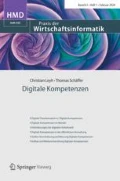Zusammenfassung
Im Rahmen der Digitalisierung ist die zunehmende Automatisierung von bisher manuellen Prozessschritten ein Aspekt, der massive Auswirkungen auf die zukünftige Arbeitswelt haben wird. In diesem Kontext werden an den Einsatz von Softwarerobotern zur Prozessautomatisierung hohe Erwartungen geknüpft. Bei den Implementierungsansätzen wird die Diskussion aktuell insbesondere durch Robotic Process Automation (RPA) und Chatbots geprägt. Beide Ansätze verfolgen das gemeinsame Ziel einer 1:1-Automatisierung von menschlichen Handlungen und dadurch ein direktes Ersetzen von Mitarbeitern durch Maschinen. Bei RPA werden Prozesse durch Softwareroboter erlernt und automatisiert ausgeführt. Dabei emulieren RPA-Roboter die Eingaben auf der bestehenden Präsentationsschicht, so dass keine Änderungen an vorhandenen Anwendungssystemen notwendig sind. Am Markt werden bereits unterschiedliche RPA-Lösungen als Softwareprodukte angeboten. Durch Chatbots werden Ein- und Ausgaben von Anwendungssystemen über natürliche Sprache realisiert. Dadurch ist die Automatisierung von unternehmensexterner Kommunikation (z. B. mit Kunden) aber auch von unternehmensinternen Assistenztätigkeiten möglich. Der Beitrag diskutiert die Auswirkungen von Softwarerobotern auf die Arbeitswelt anhand von Anwendungsbeispielen und erläutert die unternehmensindividuelle Entscheidung über den Einsatz von Softwarerobotern anhand von Effektivitäts- und Effizienzzielen.
Abstract
In the context of digitalization, the increasing automation of manual process steps is an aspect that will have massive effects on future working environments. In particular, the use of software robots for process automation induces high expectations. With regard to implementation, the discussion is currently coined by Robotic Process Automation (RPA) and chatbots. Both approaches pursue the common goal of a 1:1 automation of human actions and thus intend a direct replacement of employees by machines. With RPA, processes are learned and executed automatically by software robots. Thereby, RPA solutions emulate the input on the existing presentation layer. Hence, no changes to existing application systems are necessary. Various RPA solutions are already offered in the market as software products.Chatbots are used to organize the input and output of application systems via natural language, which makes it possible to automate the process of external communication (e.g., with customers) but also within the company (e.g., for assistance functions). This contribution identifies the effects of software robots on work environments on the basis of application examples and discusses the company-individual decision about the use of software robots on the basis of effectiveness and efficiency goals.



Notes
Verfahren zum Auslesen von Texten aus Computerbildschirmen, bspw. von Webseiten.
Literatur
Allweyer T (2016) Robotic Process Automation – Neue Perspektiven für die Prozessautomatisierung
Alpar P, Alt R, Bensberg F et al (2016) Anwendungsorientierte Wirtschaftsinformatik: strategische Planung, Entwicklung und Nutzung von Informationssystemen, 8. Aufl. Springer Vieweg, Wiesbaden
Bensberg F (2010) BI-Portfoliocontrolling: Konzeption, Methodik und Softwareunterstützung, 1. Aufl. Nomos, Baden-Baden
Bensberg F, Buscher G, Czarnecki C (2019) Digital transformation and IT topics in the consulting industry: a labor market perspective. In: Nissen V (Hrsg) Advances in consulting research. Springer, Cham, S 341–357
Brandtzaeg PB, Følstad A (2017) Why people use Chatbots. In: Kompatsiaris I, Cave J, Satsiou A, al (Hrsg) Internet science. Springer, Cham, S 377–392
Czarnecki C, Auth G (2018) Prozessdigitalisierung durch Robotic Process Automation. In: Barton T, Müller C, Seel C (Hrsg) Digitalisierung in Unternehmen. Springer, Wiesbaden, S 113–131
Czarnecki C (2018) Robotergesteuerte Prozessautomatisierung. In: Gronau N, Becker J, Kliewer N et al (Hrsg) Enzyklopädie der Wirtschaftsinformatik – Online-Lexikon, 10. Aufl. GITO, Berlin
Dengler K, Matthes B (2015) Folgen der Digitalisierung für die Arbeitswelt: Substituierbarkeitspotenziale von Berufen in Deutschland. IAB-Forschungsbericht
Ellram LM (1995) Total cost of ownership: an analysis approach for purchasing. Int J Phys Distrib Logist Manag 25:4–23. https://doi.org/10.1108/09600039510099928
Espig A, Klimpel N, Rödenbeck F, Auth G (2019) Bewertung des Kundennutzens von Chatbots für den Einsatz im Servicedesk. In: Proc. of. 14th International Conference on Wirtschaftsinformatik, S 817–831
Frey CB, Osborne MA (2013) The future of employment: how susceptible are jobs to computerisation? Technol Forecast Soc Change 114:254–280
Grob HL, Lahme N (2004) Total Cost of Ownership-Analyse mit vollständigen Finanzplänen. Controlling 16:157–164. https://doi.org/10.15358/0935-0381-2004-3-157
Heo M, Lee KJ (2018) Chatbot as a new business communication tool: the case of Naver talktalk. Commun Res Pract 1:41–45
Kirchner K, Lemke C, Brenner W (2018) Neue Formen der Wertschöpfung im digitalen Zeitalter. In: Barton T, Müller C, Seel C (Hrsg) Digitalisierung in Unternehmen. Springer, Wiesbaden, S 27–45
Kreutzer R, Neugebauer T, Pattloch A (2017) Digital Business Leadership: digitale Transformation – Geschäftsmodell-Innovation – agile Organisation – Change-Management. Springer Gabler, Wiesbaden
Leontief W, Duchin F (1986) The future impact of automation on workers. Oxford University Press, New York
Scheer A‑W (2017) Performancesteigerung durch Automatisierung von Geschäftsprozessen. AWS-Institut für digitale Produkte und Prozesse, Saarbrücken
Schmitz M, Dietze C, Czarnecki C (2018) Enabling digital transformation through robotic process automation at deutsche Telekom. In: Urbach N, Röglinger M (Hrsg) Digitalization cases. Springer, Berlin Heidelberg
Schneider D, Wisselink F, Czarnecki C (2018) Nutzen und Rahmenbedingungen informationsgetriebener Geschäftsmodelle des Internets der Dinge. In: Barton T, Müller C, Seel C (Hrsg) Digitalisierung in Unternehmen. Springer, Wiesbaden, S 67–85
Stäcker O, Stanoevska-Slabeva K (2018) Quo vadis Chatbots? Wirtsch Manag 10:38–46. https://doi.org/10.1007/s35764-018-0122-x
Stoeckli E, Uebernickel F, Brenner W (2018) Exploring affordances of slack integrations and their actualization within enterprises – towards an understanding of how chatbots create value
Urbach N, Ahlemann F (2017) Die IT-Organisation im Wandel: Implikationen der Digitalisierung für das IT-Management. HMD Prax Wirtschaftsinform 54:300–312. https://doi.org/10.1365/s40702-017-0313-6
Willcocks L, Lacity M, Craig A (2015) The IT function and robotic process automation. The London School of Economics and Political Science, London
Zangemeister C (2000) Erweiterte Wirtschaftlichkeitsanalyse (EWA): Grundlagen, Leitfaden und PC-gestützte Arbeitshilfen für ein „3-Stufen-Verfahren“ zur Arbeitssystembewertung, 2. Aufl. NW, Verl. für Neue Wiss, Bremerhaven
Author information
Authors and Affiliations
Corresponding author
Rights and permissions
About this article
Cite this article
Czarnecki, C., Bensberg, F. & Auth, G. Die Rolle von Softwarerobotern für die zukünftige Arbeitswelt. HMD 56, 795–808 (2019). https://doi.org/10.1365/s40702-019-00548-z
Received:
Revised:
Accepted:
Published:
Issue Date:
DOI: https://doi.org/10.1365/s40702-019-00548-z

